Apparel Standards and Regulations in the US- A Guide to Compliance
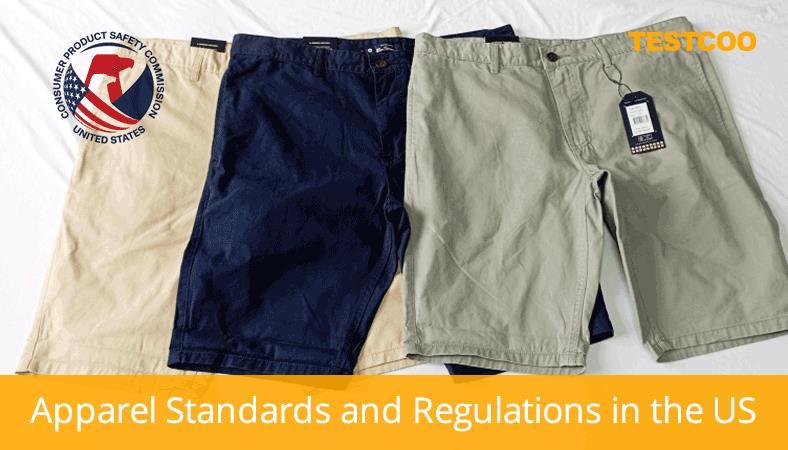
TESTCOO inspection report picture for apparel pre-shipment inspection
Wearing apparel manufactured, imported, and sold in the United States is subject to a series of standards and regulations concerning labeling requirements, fire safety standards, chemicals, and heavy metals restrictions. Manufacturers and importers are both responsible for ensuring that their apparel comply with all applicable product safety standards in the US.
This article aims to outline key considerations that US buyers should be aware of regarding these standards and regulations for apparel and textile products
service@testcoo.com
www.testcoo.com
Apparel Standards and Regulatory Requirements in the US Market
Import to or sell in the US are required to test the product in accordance with the CPSC’s regulations for apparel and issue a General Certificate of Conformity (GCC) that provides evidence of the product’s compliance.
1. Labeling Requirements
Clothing imported and sold in the United States must comply with requirements for labeling products made of cashmere, cotton, down, feather, fur, wool, rayon made from bamboo or other materials; attaching care instructions to garments, and more.
16 CFR Part 303 Rules and Regulations Under the Textile Fiber Products Identification Act requires that certain textiles sold in the United States carry labels disclosing:
generic names
percentages by weight of the constituent fibers in the product
the manufacturer or marketer name
the place of origin
1) Wool Products labeling standards
The product including specialty wools like cashmere, camel hair, mohair, alpaca, llama, or vicuna must comply with the Wool Products Labeling Act.
The wool products labeling standards request that the labels must accurately contain:
the true fiber content
the country of origin
the name or registered identification number (RN or WPL number) issued by the FTC to the manufacturer or marketer
a safe cleaning method.
TestingisImportant
You'reresponsiblefortheaccuracyofthelabel,evenifyouimport,distributeorsellwool products manufactured by another company. You can’t necessarily rely on an invoice statementthatthegoodscontainaspecifiedamountofcashmere.Routinetestingoffiber contentsbyaqualified,independenttestinglabisthebestwaytoassureaccuratelabels.
service@testcoo.com www.testcoo.com
ContactusnowtodiscovermoreaboutTESTCOOLabtestingservice
Read more: Cachet of Cashmere: Complying with the Wool Products Labeling Act
2) Labeling and Advertising Cotton Products
If you advertise or sell clothing or household items containing cotton, the product labels must reflect the fabric content accurately.
Read more: Calling It Cotton: Labeling and Advertising Cotton Products
3) Care Labeling of Textile Wearing Apparel & Certain Piece Goods
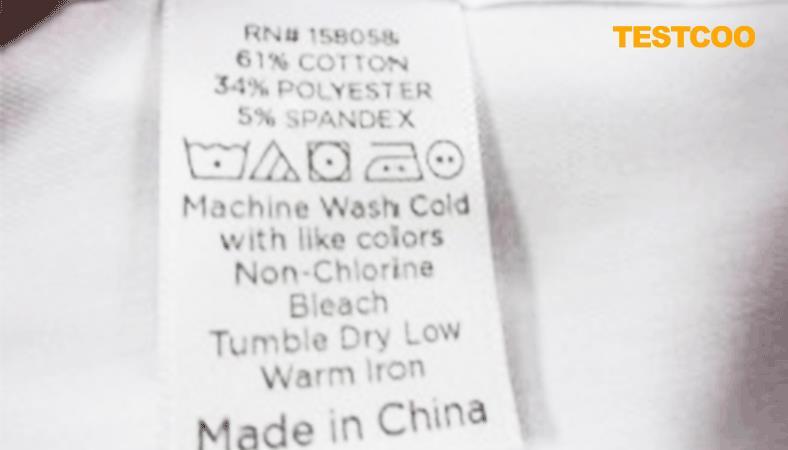
16 CFR Part 423 contains care labeling requirements. It mandates importers and manufacturers of textile wearing apparel, as well as certain piece goods, to include regular care instructions.
Covered products:
Textile apparel worn to cover or protect the body
Piece goods sold for making apparel at home
Excluded products: shoes, gloves and hats, handkerchiefs, belts, suspenders and neckties
service@testcoo.com
www.testcoo.com
Labeling Clothing
Attach labels so consumers can easily see or find them at the point of sale.
If packaging gets in the way, place additional care information on the outside of the package or on a hang-tag attached to the product.
Labels must be attached permanently and securely.
Labels must be legible during the useful life of the product.
Writing Care Instructions
Labels for clothing must have a washing or dry cleaning instruction. If an item can be washed and dry cleaned, the label needs only one of these instructions.
Five Elements of a proper washing instructions:
01. Washing by hand or by machine: The label must say whether the product should be washed by hand or machine, and give a water temperature setting if regular use of hot water will harm the product.
02. Bleaching: If all commercially available bleaches can be used on a regular basis without harming the product, the label doesn’t have to mention bleach. If using chlorine bleach on a regular basis will harm the product, but using non-chlorine bleach on a regular basis won’t, the label must say, "Only non-chlorine bleach, when needed." If all commercially available bleaches would harm the product when used on a regular basis, the label must say, "No bleach" or "Do not bleach."
03. Drying: The label must say whether the product should be dried by machine or another method. Unless regular use of high temperature will harm the product when machine dried, it’s not necessary to indicate a temperature setting.
04. Ironing: If a product needs repeated ironing, the care label must give ironing information. If regular use of a hot iron won’t harm a product, it’s not necessary to indicate a temperature setting.
05. Warnings: If you have a reasonable expectation that a consumer could use a care procedure that will harm the product, the label must contain a warning like "Do not," "No," or "Only," to warn against the harmful procedure. If a care procedure on one product could harm another product that is washed with it, the label must include a warning

The Care Labeling Rule, which requires manufacturers and importers of textile wearing apparelandgoods;providesregularinstructionstopurchasersthroughcarelabelsorother methods;prohibitsdeceptiveactsorpracticesthatfailtodiscloseinstructionstoregularcare; requiresappropriateterminologyandsymbolsthataccuratelydescribecareprocedures.
service@testcoo.com www.testcoo.com
Read more: Clothes Captioning: Complying with the Care Labeling Rule
2. Apparel flammability regulation
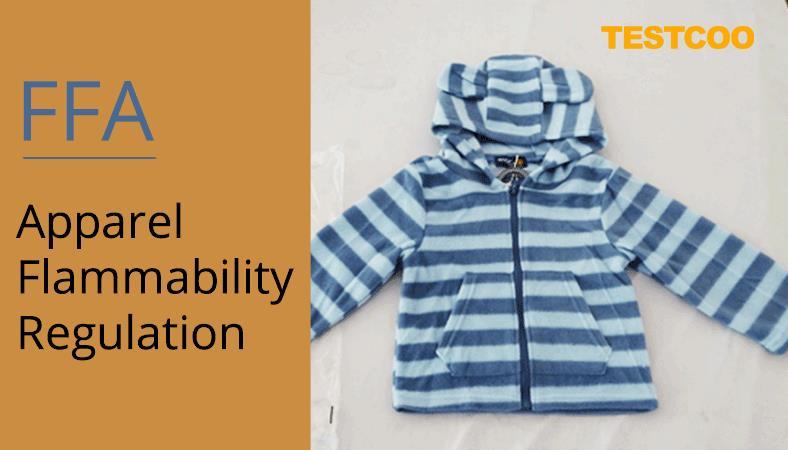
The Flammable Fabrics Act (FFA) regulates the flammability standards for the clothing textiles, vinyl plastic film, carpets and rugs, children's sleepwear and mattresses and mattress pads.
-16 CFR Part 1610 – Standard for the Flammability of Clothing Textiles
16 CFR Part 1610 sets up flammability testing standards, methods, and performance requirements for textile clothing products. It is designed to keep dangerously flammable textiles and garments made of these textiles out of commerce.
Wearing apparel includes any costume or article of clothing that people wear. The regulation16 CFR part 1610 applies to all wearing apparel, except the following items:
Hats that do not cover the neck, face, or shoulders;
Gloves that are 14 inches in length or shorter and are not attached to a garment;
Footwear that does not consist, in whole or in part, of hosiery and is not attached to a garment;
Interlining fabrics when they are intended or sold for use as a layer between an outer shell and an inner lining.
service@testcoo.com
www.testcoo.com
Most children’s sleepwear must also meet more stringent flammability requirements.
16 CFR § 1610.4 specifies testing procedures to determine the flammability of textiles used in apparel as one of three classes of flammability. Specimens cut into 2-inch by 6-inch swatches must be tested to determine the class and hazard rating.
Class 1-textiles are plain surface and raised surface fabrics that exhibit normal flammability and are acceptable for use in wearing apparel.
Class 2- textiles are raised surface fabrics that exhibit intermediate flammability and should be used with caution for wearing apparel. This class is not applicable to plain surface fabrics.
Class 3- textiles are plain surface and raised surface fabrics that are dangerously flammable and shall not be used in wearing apparel.
Howcangarmentmanufacturers,importers,orretailersbesurethatthefabricsorgarments theysellarenotdangerouslyflammable?

1)Youshouldpurchasefabricsorgarmentsmadefromtheexemptfabrics.
2) You should hire a third-partylabtoconductreasonableandrepresentativetestingon fabric(beforecuttingandsewingitintogarments)oronfinishedgarments
3)Youshouldpurchasefabricsorgarmentsfromasupplierwhoissuesaguaranteethatthey complywiththeseflammabilityrequirements.
Read more: 16 CFR § 1610 – CPSC Compliance Guide on the Standard for the Flammability of Clothing Textiles
-16 CFR Part
1615
and
Part 1616
– Standards for the Flammability of Children’s Sleepwear
Children’s sleepwear is any article of clothing, such as a nightgown, pajama, robe or loungewear, that is sized above 9 months and up to size 14 and that is intended to be worn primarily for sleeping or activities related to sleeping.
The purpose of these rules is to protect children from burns. These rules require that children’s sleepwear must be flame resistant and self-extinguish if a flame from a candle, match, lighter or a similar item causes it to catch fire. The regulations cover all children’s sleepwear above size 9 months and up to size 14 and require that:
service@testcoo.com www.testcoo.com
-the fabric and garments must pass certain flammability tests; or -be "tight fitting" as defined by specified dimensions
16 CFR part 1615 sets for children’s sleepwear sized above 9 months and up to 6X, and at 16 CFR part 1616 for children’s sleepwear sized 7 through 14. The two rules contain basically the same requirements, with the main difference being the sizes of the garments covered by each.
Test methods of flammability for children’s sleepwear
Testing for flammability involves selecting and testing a specified number of samples of three different items – fabric, prototype seams and trim, and production garment seams. Fabric (or garments) must be tested as produced (or after one laundering) and after 50 launderings. Depending on the results of testing, an item may be accepted, rejected, or require additional sampling and testing. In general, a sample of five specimens cannot have an average char length greater than 7.0 inches or have more than a specified number of individual 10-inch char lengths.
Read more: 16 CFR § 1615 and 1616 – CPSC webpage on Children’s Sleepwear Regulations
3. General Certificate of Conformity (GCC)-Additional Requirements for Adult Wearing Apparel
Adult wearing apparel is required to have a General Certificate of Conformity (GCC)
Manufacturers and importers of general-use products for which consumer product safety rules apply, such as adult wearing apparel, must certify, in a written GCC, based on testing or a reasonable testing program that the products comply with 16 CFR part 1610.
The General Certificate of Conformity (GCC) is a document that is self-issued by importers or manufacturers of non-children’s products to demonstrate that the products:
1). Have been tested according to the applicable CPSC’s safety standards or regulations;
2). Comply with the technical and regulatory requirements.
A GCC require the following 7 elements:
1). Product information (product name, model/batch number)
2). Standards that the products comply with (e.g., 16 CFR Part 1610).
3). Contact information of the domestic manufacturer or importer (name, full mailing address, and telephone number of the firm)
Identification of the domestic manufacturer or importer certifying compliance of the product
Provide the name, full mailing address, and telephone number of the firm.
4) Contact information for the individual maintaining records of test results (name, full
service@testcoo.com www.testcoo.com
mailing address, e-mail address, and telephone number)
5). Production information (place of origin, manufacturing date)
6) Testing information (date of the test or test report and location of testing)
7). Information about the testing agency (where the product is tested)
4. American Association of Textile Chemists and Colorists (AATCC)
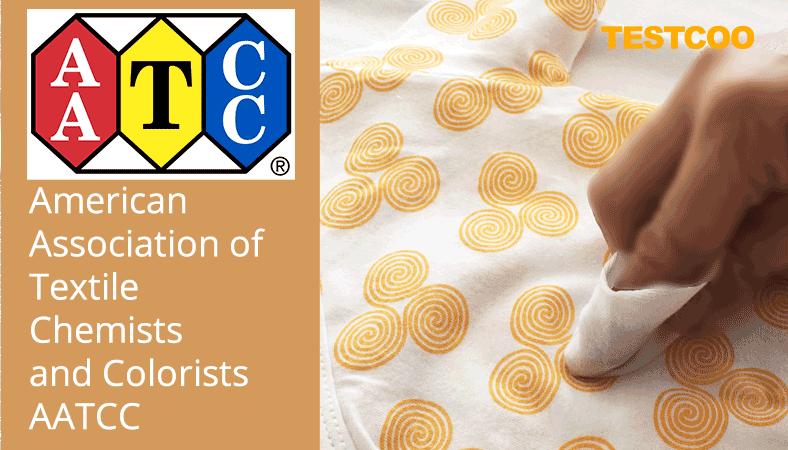
American Association of Textile Chemists and Colorists (AATCC) is an organization that develops testing standards for the textile industry. AATCC testing standards cover different aspects of apparel quality control, including colorfastness, shrinkage, fabric quality, and seam quality.
AATCC standards improve durability, assure quality color levels, and aid the development of lasting textile products.
Here we list several standards that are relevant to apparel products:
1) AATCC TM8 Colorfastness to Crocking: Crockmeter: This test method is designed to determine the amount of color transferred from the surface of colored textile materials to other surfaces by rubbing.
Test method is employing white test cloth squares, both dry and wet with water, which is commonly used in apparel and garment quality inspection by third-party inspection agency
service@testcoo.com www.testcoo.com
(Like TESTCOO Inspection)to check the colorfastness of garment when performance a final random inspection
Learn more garment inspection checklist: 13 Essential Garment Inspection Checklist in Quality Control
2) AATCC TM15 Colorfastness to Perspiration: This test method is used to determine the fastness of colored textiles to the effects of acid perspiration.
3) AATCC TM20 Fiber Analysis: Qualitative this test method describes the physical, chemical, and microscopical techniques for identifying textile fibers used commerically in the United States.
4) AATCC TM20A Fiber Analysis: Quantitative: This method presents individual procedures for the quantitative determination of moisture content, nonfibrous content and fiber composition of textiles.
5) AATCC TM81 pH of the Water-Extract from Wet Processed Textiles: This test method determines the pH of wet processed textiles.
6) AATCC TM112 Formaldehyde Release from Fabric: Sealed Jar: This test method is applicable to textile fabrics that evolve formaldehyde, particularly fabrics finished with chemicals containing formaldehyde.
5. Substantial Product Hazard List (16 CFR Part 1120) –Drawstrings in Children’s Upper Outerwear
The CPSC has listed children’s upper outerwear with hood and neck drawstrings in sizes 2T to 12 in Part 1120 – Substantial Product Hazard List because such products present a strangulation hazard to the children.
Importers and manufacturers of such products should make sure that their products comply with the requirements of ASTM F1816-97 Drawstrings on Children’s Upper Outerwear.
6. ASTM Textiles Standards
ASTM standards are generally voluntary standards that cover a wide range of product categories, including textiles. Some regulations may incorporate these standards by reference, making compliance with them mandatory.
service@testcoo.com www.testcoo.com
Importers and manufacturers can use ASTM’s standards to achieve product compliance. Here are several ASTM standards relevant to clothing and textiles:
1). ASTM D1230 – Standard Test Method for Flammability of Apparel Textiles
2). ASTM D5489 – Standard Guide for Care Symbols for Care Instructions on Textile Products
3). ASTM D3938-18 – Standard Guide for Determining or Confirming Care Instructions for Apparel and Other Textile Products
4). ASTM D1777-96 – Standard Test Method for Thickness of Textile Materials
5). ASTM D6545-22 – Standard Test Method for Flammability of Textiles Used in Children’s Sleepwear
7. Consumer Product Safety Improvement Act (CPSIA)
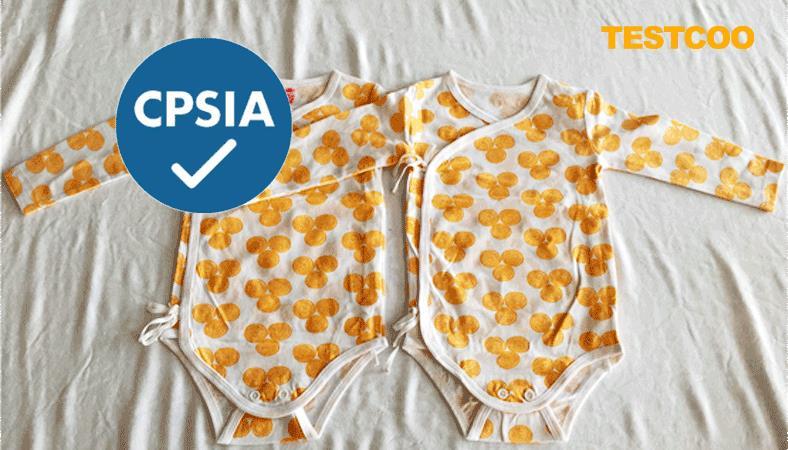
US manufacturers and importers are required to conduct chemical testing for compliance to CPSIA
US manufacturers and importers are required to conduct chemical testing for compliance to the U.S. Consumer Product Safety Improvement Act (CPSIA)
The CPSIA included provisions addressing, among other things, lead, phthalates, toy safety, durable infant or toddler products, third-party testing and certification, tracking labels, imports, ATVs, civil and criminal penalties and SaferProducts.gov, a publically-searchable database of reports of harm.
The CPSIA restricts levels of hazardous materials in products, especially those for children. For apparel, this concerns details such as snap closures, zippers or decorative prints.
service@testcoo.com www.testcoo.com
Federal law requires manufacturers and importers to test many consumer products for compliance with consumer product safety requirements. Based on passing test results, the manufacturer or importer must certify:
1) the consumer product as compliant with the applicable consumer product safety requirements in a written or electronic certificate.
2) Certificates are required to accompany the applicable product or shipment of products covered by the certificate
3 a copy must be provided to retailers, distributors and, upon request, to the government.
8. Federal Hazardous Substances Act (FHSA)
The FHSA regulates household products that contain potentially dangerous substances such as corrosive, reactive, and toxic substances. The FHSA requires labeling to alert consumers about the potential hazards and what they need to do to protect themselves from those hazards.
The FHSA also covers flammable chemicals and fire retardants that are commonly used in the textile industry. Formaldehyde, which is a chemical substance used to increase wrinkle and crease resistance in textiles, is an example of a substance restricted under the FHSA.
The label on the immediate package of a hazardous product, and any outer wrapping or container that might cover up the label on the package, must have the following information in English:
(1) The name and business address of the manufacturer, packer, distributor, or seller;
(2) The common or usual or chemical name of each hazardous ingredient;
(3) The signal word “Danger” for products that are corrosive, extremely flammable, or highly toxic;
(4) The signal word “Caution” or “Warning” for all other hazardous products;
(5) An affirmative statement of the principal hazard or hazards that the product presents, for example, “Flammable”, “Harmful if Swallowed”, “Causes Burns”, “Vapor Harmful”, etc.;
(6) Precautionary statements telling users what they must do or what actions they must avoid to protect themselves;
(7) Where it is appropriate, instructions for first aid treatment to perform in the event that the product injures someone;
(8) The word “Poison” for a product that is highly toxic, in addition to the signal word “Danger”;
(9) If a product requires special care in handling or storage, instructions for consumers to follow to protect themselves; and
(10) The statement “Keep out of the reach of children”. If a hazardous product such as a plant does not have a package, it still must have a hang tag that contains the required precautionary information. That information must also be printed in any literature that accompanies the product and that contains instructions for use.
service@testcoo.com www.testcoo.com
The FHSA also gives the CPSC the authority to enforce violations of its requirements.
TESTCOO Inspection's Expertise in Apparel QualityControl
It is crucial to meet the required quality standards and regulations for wearing apparels manufactured, imported, and sold in the US. Importers or buyers who outsource or manufacture apparel from abroad must ensure their products manufactured under the quality control.
At TESTCOO, we are well-equipped to handle quality control inspections for apparel. With our network of inspectors located in key exporting cities across China, Asia, Europe, and Africa, we can provide prompt and efficient inspection service coverage for our clients
Our quality control experts will help you determine which inspection and tests are required for your products to qualify to meet the US regulations, identify potential issues such as colorfastnesss, shrinkage, titching defects, fabric flaws. We can also ensure that the labeling and packaging of the apparel meet the CPSIA requirements, saving you time and money.
Let TESTCOO manage your quality inspection and testing protocol, ensuring quality, safe products that comply with applicable laws and regulations while keeping your customers be satisfied
Contact us to learn more about our customized Apparel Quality Control and how we can help construct a safe supply chain

TESTCOO
Global Quality Control Service Provider
Contact Us:
W: www.testcoo.com
E: service@testcoo.com
T: +86 57185787282
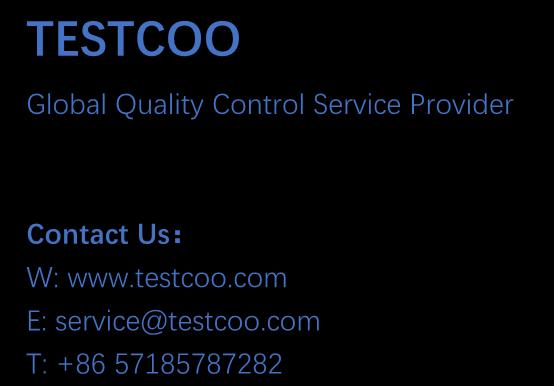
service@testcoo.com
www.testcoo.com
